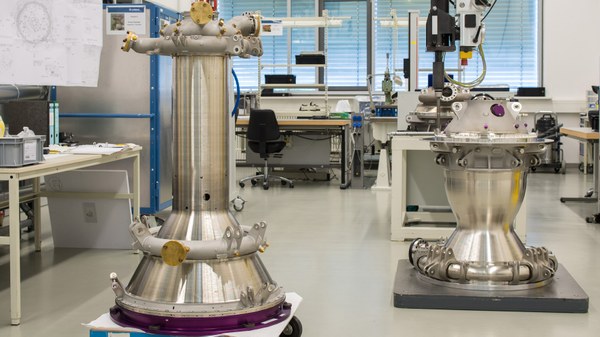Test Position P4.1

Video: Test campaign of the Vinci upper stage engine at DLR in Lampoldshausen
Your consent to the storage of data ('cookies') is required for the playback of this video on Youtube.com. You can view and change your current data storage settings at any time under privacy.
The P4 test stand was developed and built between 1963 and 1966 as part of the ELDO program and has been used as a test facility for upper stage engines as part of the Ariane program since the 1970s. Significant modifications were made in 2002, converting test position P4.1 from a test stand for testing upper stages under atmospheric conditions to a high-altitude simulation test stand. This conversion was carried out in order to create suitable test conditions for the Vinci engine. The special properties of this cryogenic and re-ignitable upper stage engine with 180 kN vacuum thrust – originally planned with a retractable nozzle extension – dictated the dimensions of the altitude chamber and the high demands on the vacuum system. The altitude chamber has side lengths of 5.5 meters and a height of 6.5 meters in order to test the engine and nozzle in a vacuum. Even at full thrust, ambient pressures of a few millibars can be maintained in the altitude simulation facility thanks to an ingenious system of recompression, in which the engine fires directly into a supersonic core diffuser, and extraction, in which the hot gas is evacuated from the facility by steam jet ejectors.
The real-time computer system controls and monitors these tests and is able to record up to 500 sensors on the test object in order to collect the data required for engine development and make it available to the customer. The measuring system enables recording rates of up to 100,000 measured values per second per channel.
The latest modification plans aim to perform engine tests under both vacuum and ground conditions without time-consuming refitting. This significantly extends the versatility and future viability of the P4.1 test position, as flight qualification tests of the core engine (i.e. without nozzle extension) can be performed without complex vacuum requirements, resulting in significant cost savings.
Areas of application
- Long-term vacuum tests for development engines
- Tests under ground conditions for aircraft engines
Fuels | Tank volume and pressure | Mass flow |
|---|---|---|
Liquid hydrogen (LH2) at 20 Kelvin (-253 °C) | 135 m3, 12 bar | up to 7 kilograms per second |
Liquid oxygen (LOX) at 90 Kelvin (-183 °C) | 50 m3, 12 bar | up to 40 kilograms per second |
Planned test object
Qualified engines
Initially, the engine was to be used in the Ariane 5 Midlife Evolution (ME). At the ESA Ministerial Council Conference in December 2014, the member states decided to develop a new launcher, Ariane 6: Ariane 6. Thanks to the re-ignition capability of the Vinci engine, several payloads can be launched from a future Ariane 6 upper stage to different orbits.


